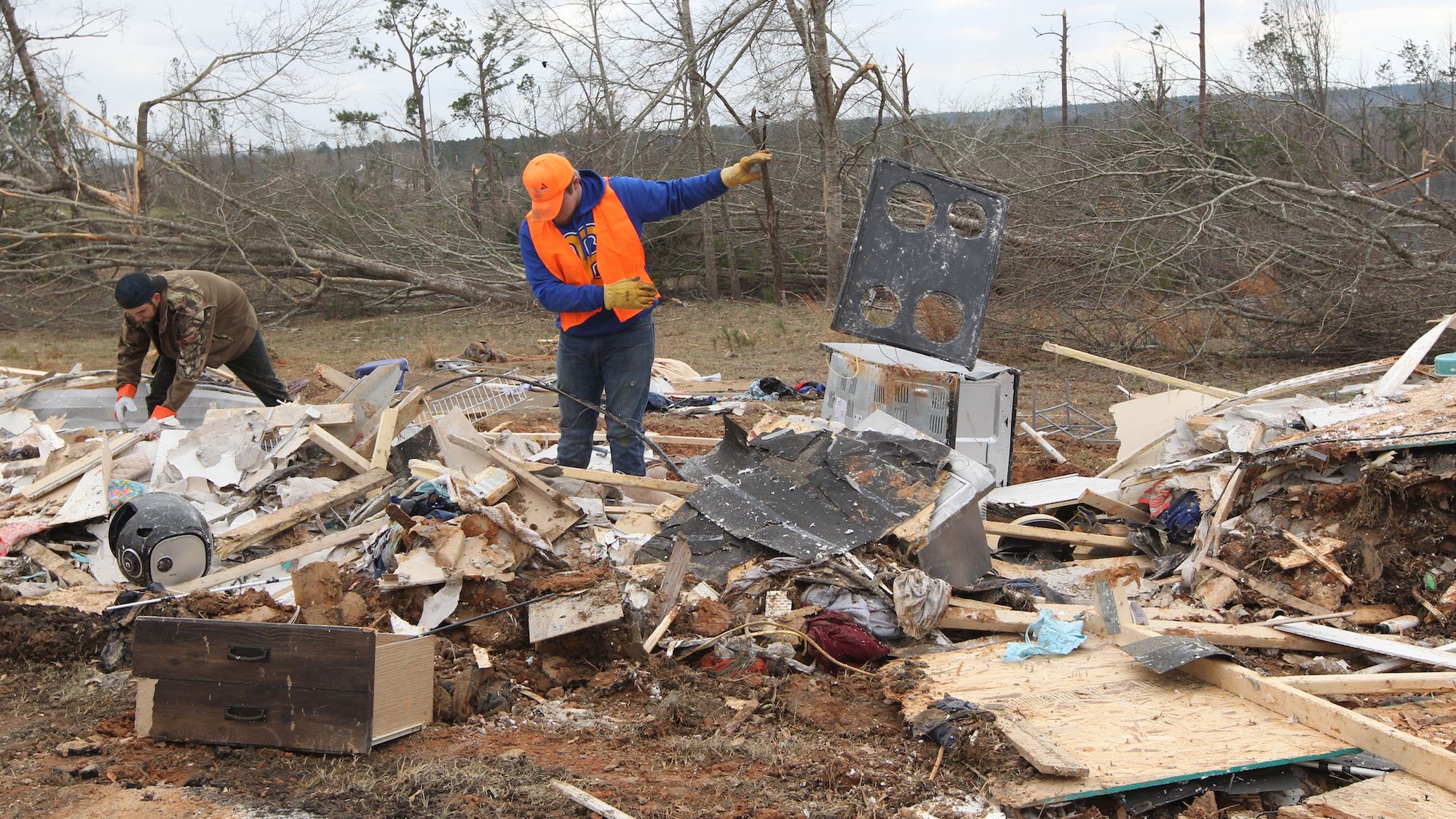
Tami Chappell/AFP/Getty Images
BEAUREGARD, Ala.—There are few deadlier places to be in a tornado than a mobile home in Alabama.
The reasons why range from location to laws. More than 80% of the state’s mobile homes are spread out in rural areas, not clustered in trailer parks, according to a recent study, making it difficult to provide adequate emergency shelter. Alabama didn’t routinely enforce installation codes for new mobile homes until 15 years ago, so it is unclear how many of its mobile homes are securely anchored to the ground.
Twenty-three people died on March 3 here in Lee County, and roughly half of those victims were inside mobile homes that were ripped from the ground by winds reaching 170 miles an hour. About 30% of rural, eastern Lee County’s housing is manufactured homes, compared with roughly 13% statewide and 6% nationwide, according to the census.
Initiatives to strengthen safety of the state’s 300,000 mobile homes—including recommendations from a panel convened after about 250 people died when tornadoes struck central Alabama in 2011—fell short for lack of money and political squabbles.
“Folks don’t want you to tell them what to do,” said Rep. Mike Rogers, as he toured the tornado damage in his district on Tuesday. “We’re culturally different than other parts of the country.”
Mr. Rogers said that while it made his heart sick to see the destruction, he opposes increased federal or state regulation that could require costly upgrades, like hiring more code officials, ensuring homes are attached by anchoring systems or requiring heavier construction materials in new homes.
“I represent a poor rural congressional district,” said Mr. Rogers, a Republican, of his 13-county district along the Georgia line, adding that many people couldn’t afford greater building requirements. He returned to Lee County on Friday to tour the site with President Trump, who promised support for rebuilding.
Alabama is one of the poorest states in the U.S., with 17% of the state’s population living below the poverty line in 2017, compared with 13% nationally, according to the census. In Lee County, 22% live in poverty.
The potential for a mobile home to be hit by a tornado is 350% greater in Alabama than in tornado-prone Kansas, largely because they are spread out here, according to a recent study by Stephen Strader, an assistant professor of geography and the environment at Villanova University.
State enforcement of federal safety standards has long been uneven here, as Alabama doesn’t have a statewide building code with inspection and compliance requirements.
Some local governments, including Lee County’s, have building codes but they don’t have jurisdiction over manufactured housing, which is the purview of the Alabama Manufactured Housing Commission. The commission, which has a dozen code officers throughout the state, oversees the installation of new or relocated manufactured homes.
In the mid-2000s, the commission began ensuring that all new mobile homes were properly anchored, said Tommy Colley, executive assistant to the commission administrator. Before then, manufactured homes would have been required by law to be anchored, he said, but it isn’t clear the law was always enforced.
The state doesn’t have records on the age of the manufactured-housing stock, but Mr. Colley estimated that about 300 new or relocated homes a month are subject to mandatory inspection. Local officials say most of the homes here predate obligatory inspection.
Manufactured homes in Alabama are required to be wind-resistant up to 70 miles an hour, the lowest of three federal rating levels. Mr. Colley, who spent part of the week inspecting mobile-home sites in the disaster zone, said most of the homes appeared to have been tied down before they were overwhelmed by the wind.
“The real big problem is people won’t leave and go to shelter,” he said. “I don’t know why.”
Lance Latham, deputy director of the trade group Alabama Manufactured Housing Association, said the industry supports increased federal research on tornado safety, as well as state-level proposals like tax credits for shelters built into manufactured homes.
“A lot of our legislature’s focus has been on trying to cut things down in government,” Mr. Latham said, in reference to recent budget shortfalls. “Perhaps after this storm, we’ll see renewed interest.”
He also said that no home, traditional or manufactured, was likely to survive 170 mile-an-hour wind, and that it is critical to evacuate early in a tornado watch.
A bright spot is the improvement in forecasting technology, with meteorologists able to give near street-level warnings an average of 13 minutes ahead of a tornado strike, down from just a few minutes in the early 1980s.
Walker Ashley, professor of geographic and atmospheric sciences at Northern Illinois University, said meteorologists did a great job warning ahead of the Alabama storm, but the deaths showed that the government needs a better way for getting warnings out and ensuring they are heeded.
“It’s the Super Bowl kick and they nailed it,” he said of the weather forecasters. “But somehow, we lost the game.”
David Roueche, an assistant professor of structural engineering at Auburn University, said simple actions like contacting people and checking whether their homes are anchored would save lives.
Communities like Joplin, Mo., and Moore, Okla., have seen improvements after strengthening construction requirements, said Mr. Roueche, who grew up in a mobile home.
“The rural communities have been ignored and overlooked, and it’s going to happen again and again and again,” he said, “until we accept that this is not inevitable.”
The post Tornado Highlights Alabama’s History of Loose Mobile-Home Codes appeared first on Real Estate News & Insights | realtor.com®.
from DIYS https://ift.tt/2VQz6vS
No comments:
Post a Comment